If you’ve ever tripped over a rogue sneaker on your way to coffee, this one’s for you. Kid shoes multiply like gremlins and somehow end up everywhere except where they should be. The good news? You don’t need a mudroom worthy of a magazine spread to keep them under control—you just need smart systems that your kids can actually follow.
Let’s tame the shoe chaos with six stylish, doable ideas that work in real homes, with real messes, and real tiny humans.
1. Entryway Zones That Do the Thinking For Them
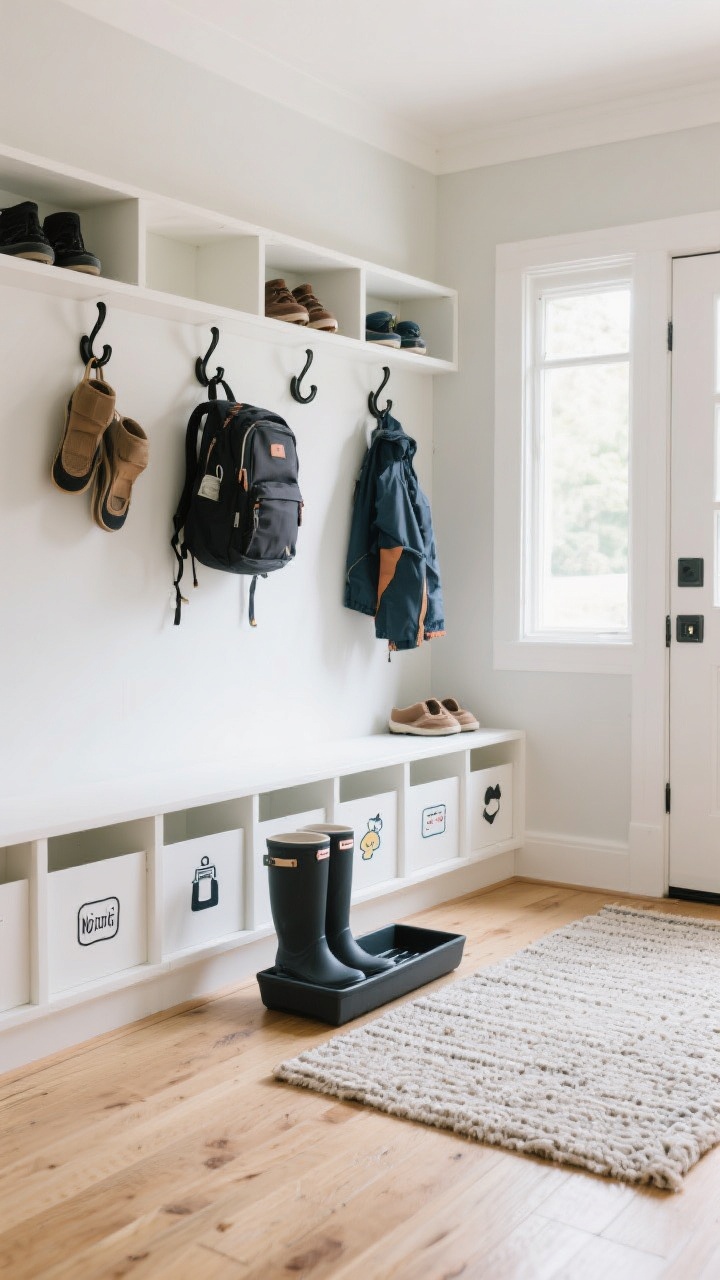
Kids don’t need complicated. They need obvious. Set up clear zones right where shoes come off—no negotiating, no wandering with muddy soles into the living room.
Make The Drop Zone Obvious
- Low cubbies or open shelves: One slot per kid. Label with their name or a cute icon for non-readers.
- Boot tray + washable rug: Catch dirt and puddles before they migrate. Choose a mat you can toss in the wash.
- Hooks above, shoes below: Keep backpacks and jackets right over the shoe spot so the routine feels natural.
Design Details That Matter
- Use contrast: Dark tray on a light floor or vice versa so kids spot it instantly.
- Go wide, not deep: Shallow shelves (10–12″) prevent black-hole shoe piles.
- Labels that last: Laminated tags, vinyl decals, or wood-burned name plates. Bonus: they look legit.
FYI, this is not about perfection—just a spot that’s so easy your kid can use it while half-asleep after soccer practice.
2. The Two-Tier Rule: Daily Shoes Up Front, Extras Out Back
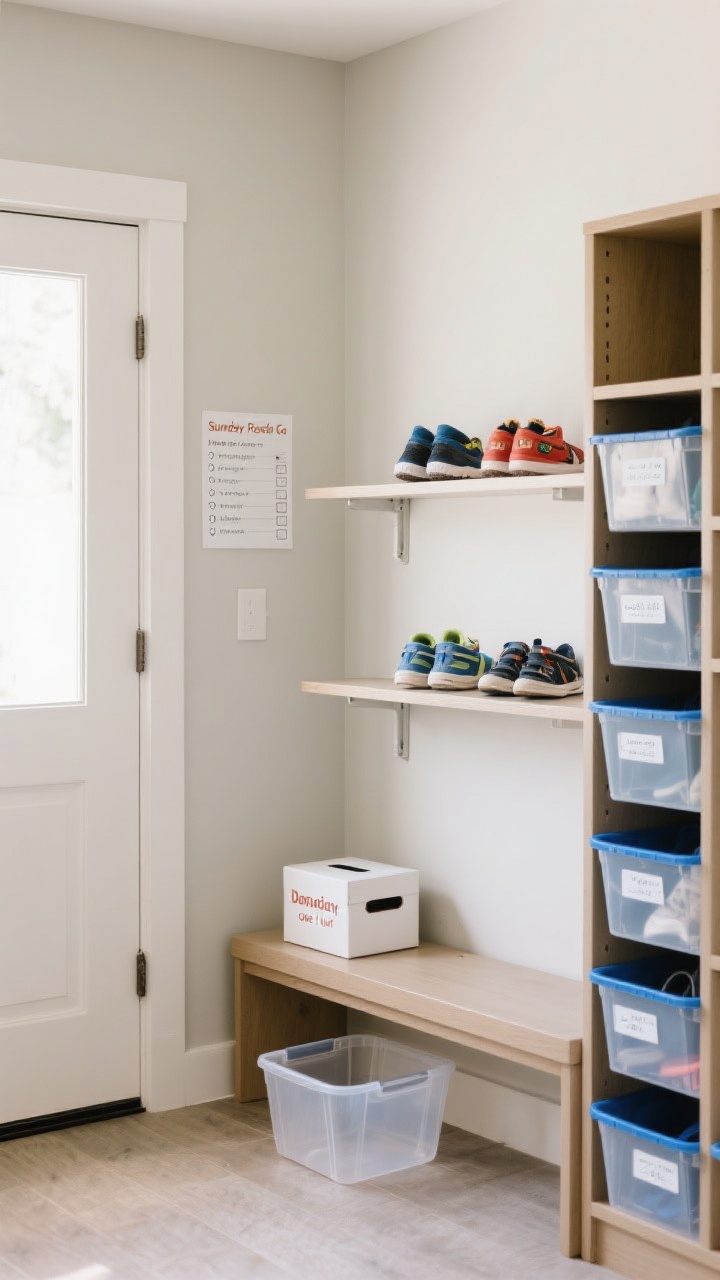
Most clutter happens because every shoe competes for attention. Solve it with a two-tier system: everyday pairs within arm’s reach and the rest stored nearby but out of the way.
How To Set It Up
- Tier 1 (Grab-and-go): 1–2 pairs per kid by the door—school sneakers and current sport shoes.
- Tier 2 (Overflow): Off-season or “sometimes” shoes on a shelf in a closet, under a bench, or in a labeled bin.
Weekly Reset Tips
- Sunday swap: Put last week’s muddy cleats back to Tier 2 and pull out what’s needed for the week.
- Use color codes: Blue bins for everyday, clear bins for overflow so you can see what’s inside.
- One-in, one-out: New shoes? Retire an old pair to donation or recycling right then.
This simple tiering prevents the “mountain of tiny shoes” phenomenon. It also makes mornings calmer, which is priceless, IMO.
3. Furniture That Works Overtime (Benches, Baskets, and Beyond)
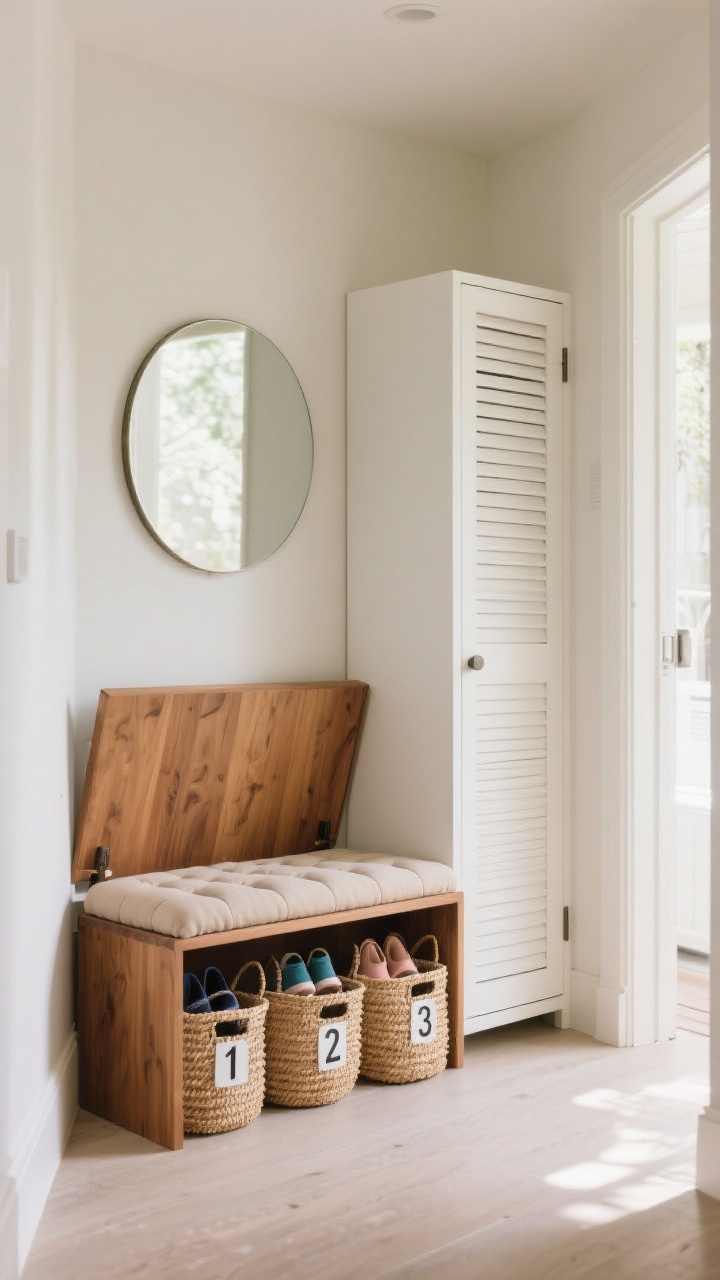
If you’re going to add furniture, make it pull double duty. Storage benches and closed shoe cabinets keep the mess hidden while looking chic.
Smart Furniture Picks
- Flip-top storage bench: Stash shoes inside, sit on top to tie laces. Add a cushion for style and comfort.
- Closed-door shoe cabinet: Slim, wall-anchored, and surprisingly roomy. Great for narrow hallways.
- Stacked crates or cube units: Customize by kid. Pull-out baskets make cleanup mindless.
Styling + Function Tricks
- Mix materials: Woven baskets + wood bench = texture and warmth.
- Ventilation matters: Choose cabinets with slats or perforations to keep odors at bay.
- Numbers, not names: If you want flexibility across kids, label baskets “1, 2, 3” instead of names.
Bonus points for adding a mirror above the bench so they can check if their shoes match. Because sometimes they won’t. And that’s okay-ish.
4. Small Space Hacks: Vertical, Under, and Over
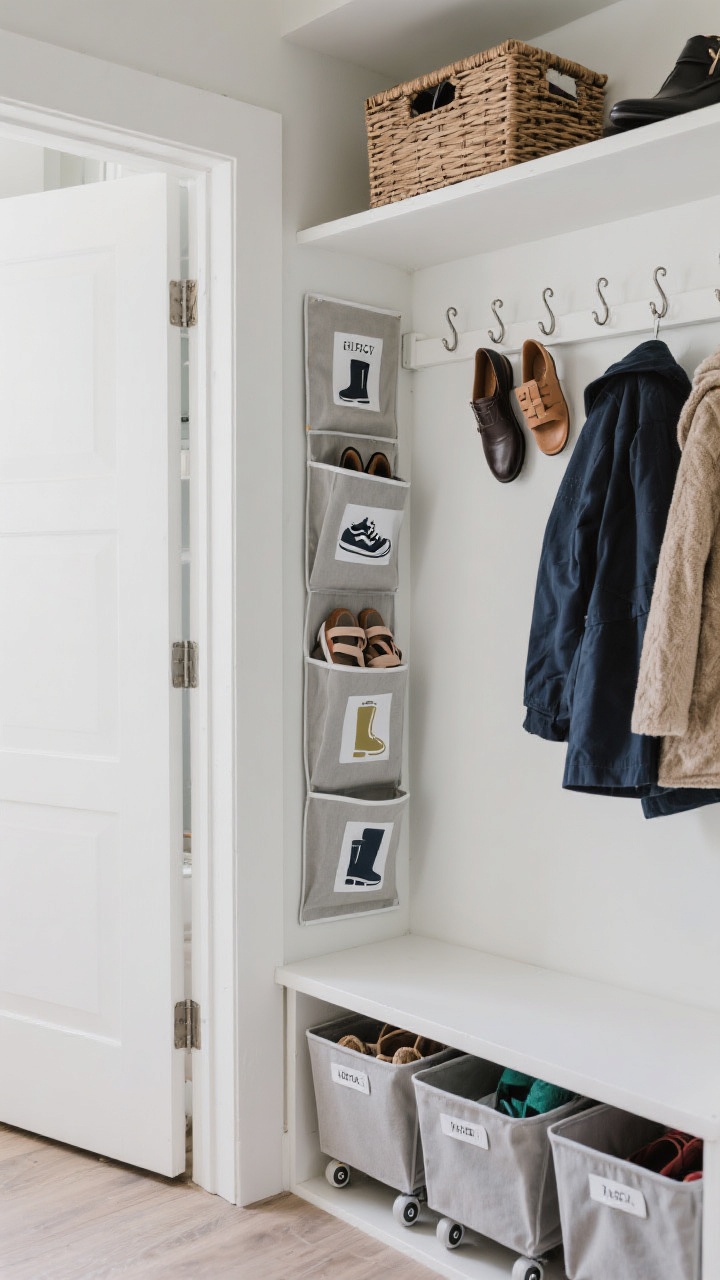
No mudroom? No problem. Think vertical and underutilized spaces. You’d be amazed what you can fit without crowding your floors.
Vertical Wins
- Over-the-door shoe organizers: Cut rows to kid height and label pockets by shoe type.
- Wall-mounted rails with S-hooks: Clip or hang lightweight shoes and keep the floor clear.
- Narrow tower shelves: Slot them near the door; one column per kid keeps the peace.
Under and Over Magic
- Under-bench rolling trays: DIY with shallow bins and stick-on casters. Pull out, dump in, slide back.
- Under-bed zip bags: Perfect for off-season shoes—choose clear tops so you can see what’s inside.
- High shelf baskets: Use the top of a coat closet for dress shoes or special-occasion pairs.
Pro tip: Measure your kid’s biggest shoes plus an inch. Nothing kills a system faster than bins that almost fit.
5. Make It Fun (Because Buy-In Beats Nagging)
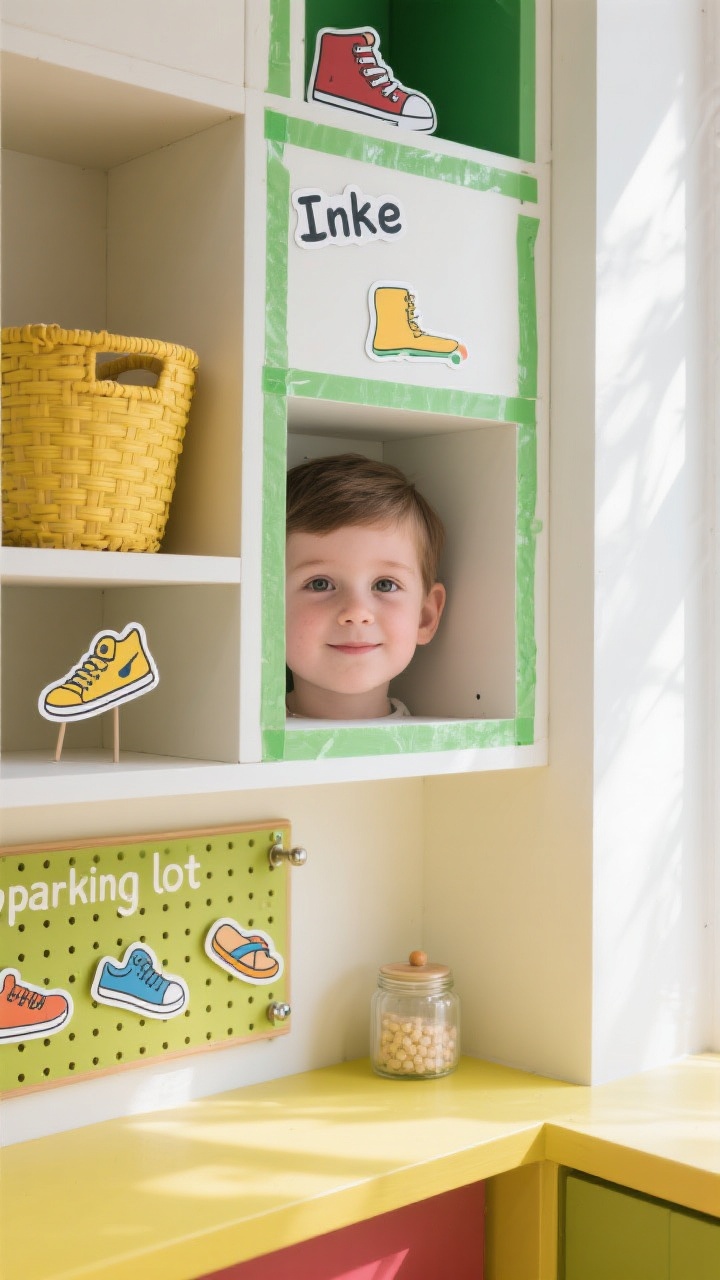
Kids are more likely to use a system if it feels like a game. Build in visual cues, mini rewards, and a touch of personality.
Personalize The System
- Color-code by kid: Green tape on shelves for one, yellow baskets for another.
- Icon labels: Sneaker, boot, sandal icons help pre-readers sort quickly.
- Sticker zones: Let them decorate their cubby—instant ownership.
Gamify The Cleanup
- Beat the buzzer: 30-second shoe sprint before dinner. Play a favorite song snippet.
- Pegboard “parking”: Paint outlines for shoes on a low board—like a tiny parking lot.
- Token jar: A token for each day shoes make it home. Trade tokens for a small privilege on weekends.
FYI, you’re not bribing—you’re training. And honestly, it works better than repeating “Put your shoes away” 47 times.
6. Keep It Fresh: Cleaning, Rotating, And Letting Go
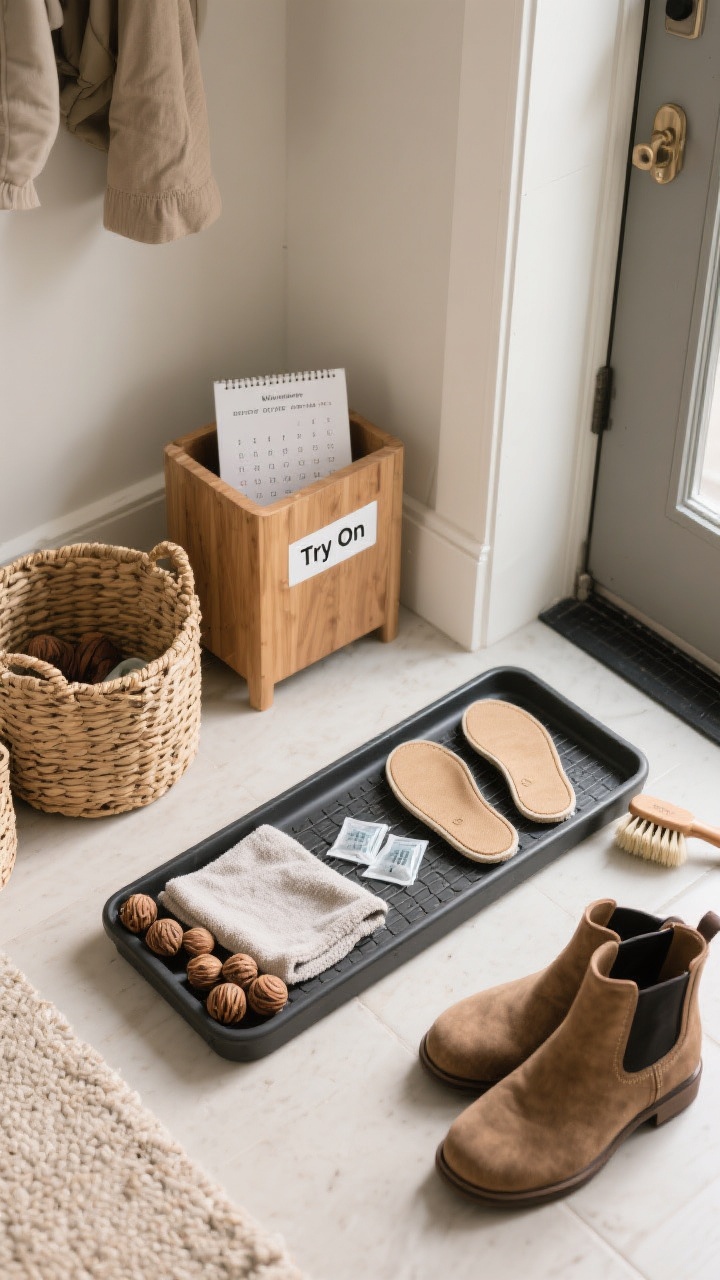
Even the best setup fails without maintenance. Keep it low effort and consistent so you don’t end up back at square one.
Quick Maintenance Routine
- Daily 60 seconds: Post-dinner tidy: all shoes back to their homes.
- Weekly wipe: Clean trays, vacuum cubbies, and do a sniff check (sorry, but necessary).
- Monthly rotate: Move outgrown pairs to a labeled “Try On” bin; donate what no longer fits.
Odor And Dirt Control
- Silica packets or cedar balls: Toss a few into each basket to curb smells.
- Boot brush at the door: A quick scrub stops mud from traveling inside.
- Machine-washable insoles: Swap or wash monthly to keep sneakers fresher longer.
Set a calendar reminder for seasonal swaps—sandals out in spring, boots in for fall. Small rituals keep the system humming without you becoming the Shoe Police.
The takeaway: Pick one idea and implement it today. Then layer a second once the first sticks. You’re not organizing for Pinterest; you’re organizing for real life—and these systems will actually survive it. Your toes (and your hallway) will thank you.
